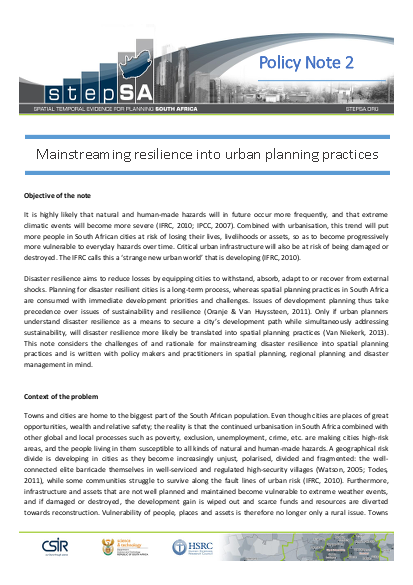
It is highly likely that natural and human-made hazards will in future occur more frequently, and that extreme climatic events will become more severe (IFRC, 2010; IPCC, 2007). Combined with urbanisation, this trend will put more people in South African cities at risk of losing their lives, livelihoods or assets, so as to become progressively more vulnerable to everyday hazards over time. Critical urban infrastructure will also be at risk of being damaged or destroyed. The IFRC calls this a ‘strange new urban world’ that is developing (IFRC, 2010). ??? Disaster resilience aims to reduce losses by equipping cities to withstand, absorb, adapt to or recover from external shocks. Planning for disaster resilient cities is a long-term process, whereas spatial planning practices in South Africa are consumed with immediate development priorities and challenges. Issues of development planning thus take precedence over issues of sustainability and resilience (Oranje & Van Huyssteen, 2011). Only if urban planners understand disaster resilience as a means to secure a city’s development path while simultaneously addressing sustainability, will disaster resilience more likely be translated into spatial planning practices (Van Niekerk, 2013). This note considers the challenges of and rationale for mainstreaming disaster resilience into spatial planning practices and is written with policy makers and practitioners in spatial planning, regional planning and disaster management in mind.
Resource collections
- UN Habitat - Urban Response Collection
- Urban Response - Urban Crisis Preparedness and Risk Reduction
- Urban Response Collection - Community Engagement and Social Cohesion
- Urban Response Collection - Economic Recovery
- Urban Response Collection - Environment and Climate Change
- Urban Response Collection - Housing, Land and Property
- Urban Response Collection - Urban Crisis Response, Recovery and Reconstruction
- Urban Response Collection - Urban Resilience
